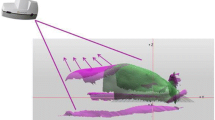Abstract
Purpose
Surface-based image guided radiotherapy (IGRT) allows positioning and/or monitoring patients in 3 dimensions (3D), without the use of ionizing radiation. In this study, we report on intra-fraction motion measured by acquisition of multiple images of 3D body surfaces.
Materials and methods
Twenty-nine patients treated for pelvic tumors were enrolled. Setup variations (SV) through three consecutive body surfaces acquired by the optical IGRT system Align-RT (Vision-RT, London, UK) were analyzed before, during and at the end of treatment delivery. Displacements along the main axes (X, Y and Z) from initial (I) to mid-treatment (MT) and final (F) acquisitions were recorded. Time and direction of SV were assessed.
Results
A total of 6272 images from 792 fractions of 29 patients were available. The main source of misalignment was between I and MT acquisition (p < 0.001). The dominant SV direction was the vertical one (Z axis), with mean SV of −1.20 ± 0.06 mm and −1.55 ± 0.06 mm for I-MT and I-F acquisitions, respectively. The Y mean components of SV were, respectively, −0.95 ± 0.10 mm and −1.0 ± 0.10 for I-MT and I-F acquisitions, while the X deviations were 0.07 ± 0.08 mm for I-MT and 0.26 ± 0.08 mm I-F.
Conclusion
Three-D surface imaging for patient setup monitoring highlighted remarkable mobility of patients during RT session, especially in the anterior–posterior direction (Z axis). The largest magnitude in patient movements occurred during the first part of delivery. These findings suggest that the initial setup control cannot not to be sufficient to guarantee treatment reproducibility, especially for long-lasting RT treatments.


Similar content being viewed by others
References
Verellen D, Depuydt T, Gevaert T et al (2010) Gating and tracking, 4D in thoracic tumours. Cancer Radiother 14(6–7):446–454
Britton KR, Takai Y, Mitsuya M et al (2005) Evaluation of inter- and intrafraction organ motion during intensity modulated radiation therapy (IMRT) for localized prostate cancer by a newly developed on-board image guided system. Radiat Med 23:14–24
Kupelian P, Willoughby T, Mahadevan A et al (2007) Multi-institutional clinical experience with the Calypso System in localization and continuous real-time monitoring of the prostate gland during external radiotherapy. Int J Radiat Oncol Biol Phys 67:1088–1098
Bert C, Metheany KG, Doppke KP et al (2006) Clinical experience with a 3D surface patient setup system for alignment of partial breast irradiation patients. Int J Radiat Oncol Biol Phys 64:1265–1274
McIntosh A, Shoushtari AN, Benedict SH et al (2011) Quantifying the reproducibility of heart position during treatment and corresponding delivered heart dose in voluntary deep inhalation breath hold for left breast cancer patients treated with external beam radiotherapy. Int J Radiat Oncol Biol Phys 81:e569–e576
Alderliesten T, Sonke JJ, van Vliet-Vroegindeweij C et al (2013) Accuracy evaluation of a 3D surface imaging system for guidance in deep-inspiration breath-hold radiation therapy. Int J Radiat Oncol Biol Phys 85:536–542
Krengli M, Gaiano G, Mones E et al (2009) Reproducibility of patient setup by surface image registration system in conformal radiotherapy of prostate cancer. Radiat Oncol 4:9
Deantonio L, Masini L, Loi G et al (2011) Detection of setup uncertainties with 3D surface registration system for conformal radiotherapy of breast cancer. Rep Pract Oncol Radiother 16:77–81
Verellen D, De Ridder M, Linthout N et al (2007) Innovations in image-guided radiotherapy. Nat Rev Cancer 7(12):949–960
Noel C, Parikh PJ, Roy M, et al. Prediction of intrafraction prostate motion: Accuracy of pre- and post-treatment imaging and intermittent imaging. Int J Radiat Oncol Biol Phys 2009;73:692e698
Mayyas E, Chetty IJ, Chetvertkov M et al (2013) Evaluation of multiple image-based modalities for image-guided radiation therapy (IGRT) of prostate carcinoma: a prospective study. Med Phys 40:041707
Li JS, Jin L, Pollack A, et al. Gains from real-time tracking of prostate motion during external beam radiation therapy. Int J Radiat Oncol Biol Phys 2009;75:1613e1620
Budiharto T, Slagmolen P, Haustermans K et al (2011) Intrafractional prostate motion during online image guided intensity-modulated radiotherapy for prostate cancer. Radiother Oncol 98:181–186
Kotte AN, Hofman P, Lagendijk JJ, et al. Intrafraction motion of the prostate during external-beam radiation therapy: Analysis of 427 patients with implanted fiducial markers. Int J Radiat Oncol Biol Phys 2007;69:419e425
Litzenberg Dale W, Balter James M, Hadley Scott W, et al. Prostate Intrafraction Translation Margins for Real-Time Monitoring and Correction Strategies, Prostate Cancer Volume 2012, Article ID 130579
Mutanga TF, de Boer HC, Rajan V et al (2012) Day-to-day reproducibility of prostate intrafraction motion assessed by multiple kV and MV imaging of implanted markers during treatment. Int J Radiat Oncol Biol Phys 83:400–407
Langsenlehner T, Döller C, Winkler P et al (2013) Impact of inter- and intrafraction deviations and residual set-up errors on PTV margins Different alignment techniques in 3D conformal prostate cancer radiotherapy. Strahlenther Onkol 189:321–328
Author information
Authors and Affiliations
Corresponding author
Ethics declarations
Conflict of interest
The authors declare that they have no conflict of interest.
Ethical standards
This article does not contain any studies with human participants or animals performed by any of the authors.
Rights and permissions
About this article
Cite this article
Apicella, G., Loi, G., Torrente, S. et al. Three-dimensional surface imaging for detection of intra-fraction setup variations during radiotherapy of pelvic tumors. Radiol med 121, 805–810 (2016). https://doi.org/10.1007/s11547-016-0659-9
Received:
Accepted:
Published:
Issue Date:
DOI: https://doi.org/10.1007/s11547-016-0659-9




